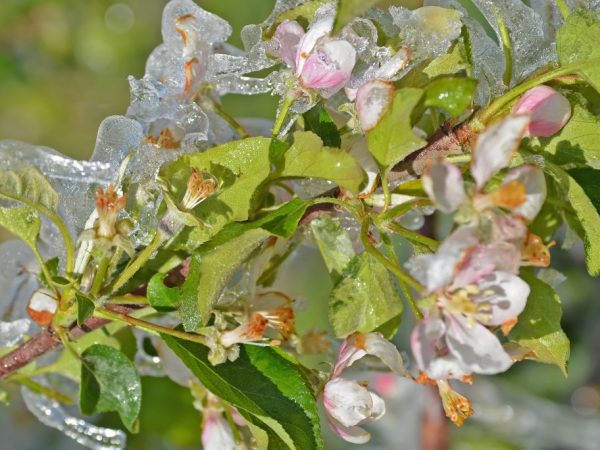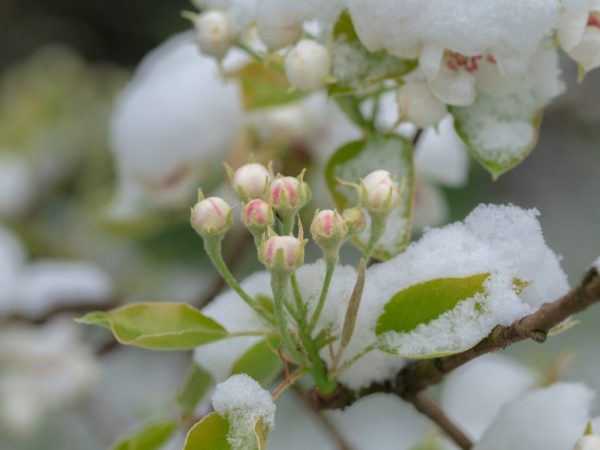What to do with a frozen pear tree
In the spring, gardeners start looking after trees and shrubs. Fruit trees are most often prone to freezing at low temperatures. One of them is pears. Signs that a pear is frozen indicate the need to take measures to save the culture. A little pruning and abundant watering is often sufficient.

What to do with a frozen pear tree
How to identify a frozen pear
Fruit trees freeze out regardless of the age of the plant.
The fact that the pear is frozen is indicated by dark shoots and bark. The core of the trunk also changes color. To check, cut a twig at the end and look at the color. In a healthy pear, it should be beige. If the shade turns brown or dark brown, the plant is frozen.
Another sign is the appearance of frostbites. These are longitudinal cracks in the crust that appear as a result of temperature differences during the day and night. During the day, under the influence of the sun, the crust heats up and expands, and at night it contracts, which is why ruptures of the upper layer appear. This deformation is cleaned, disinfected with copper sulfate, and then covered with garden varnish.
If the pears are frozen, this does not mean that the tree is dead. Often the ends of the branches freeze slightly due to dehydration during dry autumn. Another reason is that they did not have time to ripen. To avoid this, especially careful watering is necessary in the heat.
Whitewashing in the fall also serves as a protective layer against freezing.
Determination of the degree of freezing
Methods for determining the extent of damage are an effective check that the pear is not completely frozen.
There are 2 ways to check:
- A cut of a 3-4 year old branch. They put it in water for 4 days and look at the color of the wood. If the pear has a light green tint, the negative effects of frost have not been reflected on it. In addition, shoots grow on the branch and buds swell. In a heavily frozen tree, the wood turns black.
- A cut of the trunk on the bark. The intact cambium remains green, while the deceased becomes brown, close to black. Such a plant is unlikely to be saved. The wound of a living tree is covered with brilliant green immediately after the cut, and then with garden varnish or natural oil paint.
In some cases, even the black bark does not indicate the complete death of the pear. After thawing the soil, check the roots. To do this, they are dug out, an incision is made in the bark and checked for compliance with a certain color of the wood.
First steps to save the tree

A frozen pear needs to be cut
First of all, frozen pears must be pruned, regardless of the variety. Pruning is done in spring, late April – early May. Damaged parts are well tracked during this period. The procedure is carried out carefully to avoid large wounds. Otherwise, their long-term overgrowth will lead to black cancer. Further, the places of the cuts are treated with garden pitch, and the trees are abundantly and often watered with water, without adding mineral fertilizers.
A young pear (2-5 years old) can really be saved, even if it is frozen up to the snow cover.In this case, not only the top and some branches, but also its ground part are cut off completely, leaving only healthy wood.
In both situations, the trunks of frozen trees are mulched with humus. This is necessary to retain moisture and the reproduction of earthworms. The soil nearby is often loosened and burned.
Special pear care
If the plant freezes in winter, care for it is required not only in spring, but up to its full recovery. During flowering and fruit setting, most of the fruits are removed, leaving only a quarter. Abundant watering of the plant is mandatory. In October-November, water-charging irrigation is carried out, in which the soil is soaked 40 cm. Organic fertilizers are also applied under the butt of trees.
In case of slight frost penetration, it is not difficult to restore trees. If frosts have affected the root, it is better to uproot the plant and plant a new seedling.
Summarizing
Severe frosts can seriously harm pears, as a result, the tree will not bring a large harvest. Pruning properly and watering abundantly are paramount.


